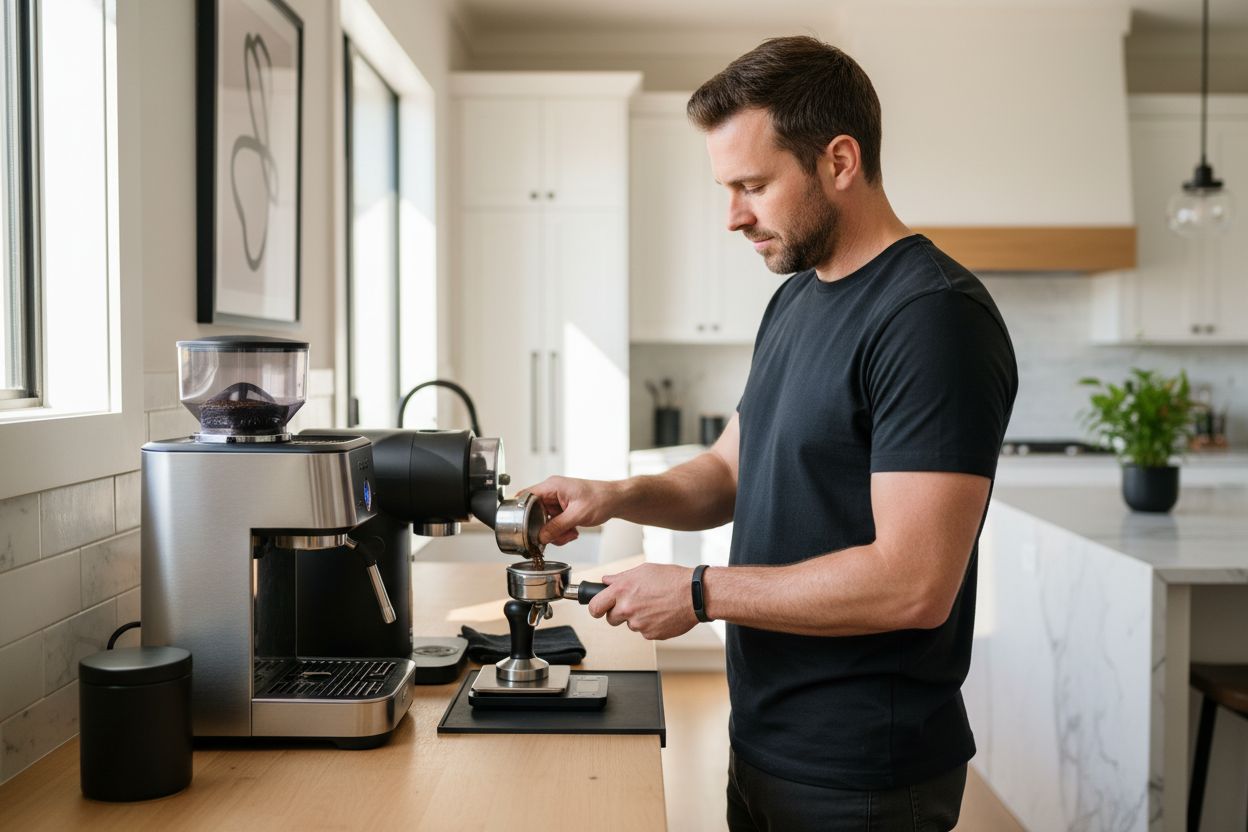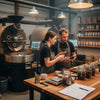What Is Espresso? Complete Guide for Coffee Lovers
- by Rock Roasters
Did you know that even the tiniest change in grind size can make or break an espresso shot? This beloved coffee style captivates drinkers not just with its bold flavor, but with the precision and care it demands. Mastering espresso means understanding how subtle differences in preparation can turn an ordinary cup into something extraordinary. Whether you crave a pure shot or a creamy variation, the true secret lies in the details.
Table of Contents
- Defining Espresso: Key Concepts And Misconceptions
- Types Of Espresso Drinks And Variations
- How Espresso Is Made: Process And Equipment
- Essential Characteristics And Taste Profiles
- Common Mistakes When Brewing Espresso
Key Takeaways
| Point | Details |
|---|---|
| Espresso Definition | Espresso is a brewing method that emphasizes extraction technique and concentration, not just strength. |
| Key Variables | Factors like grind size, water temperature, and flow uniformity significantly affect espresso quality and flavor. |
| Common Mistakes | Avoid inconsistent grind size, improper tamping, incorrect water temperature, and neglecting equipment maintenance to ensure quality. |
| Flavor Complexity | A well-crafted espresso showcases complex flavors including fruity, nutty, and sweet notes, enhanced by crema and balanced acidity. |
Defining Espresso: Key Concepts and Misconceptions
Espresso isn’t just another coffee—it’s a precise brewing method that transforms humble coffee grounds into a concentrated, rich liquid gold. Espresso represents a unique extraction technique where hot, high-pressure water is forced through finely ground coffee, creating an intense beverage with remarkable complexity.
According to research from the University of Portsmouth, espresso’s quality is remarkably sensitive to multiple variables. Factors like grind size and water flow uniformity can dramatically influence the final brew. Minute variations in these parameters can transform an excellent shot into a mediocre one, making espresso preparation more of an art than a simple mechanical process.
- Precise water temperature (around 93°C)- High pressure (approximately 9 bars)- Extremely fine coffee grind- Short extraction time (typically 25-30 seconds)
Many coffee enthusiasts mistakenly believe espresso is defined by its strength alone. In reality, it’s about extraction method and concentration. A true espresso isn’t just strong—it’s a balanced, nuanced experience where oils, acids, and aromatics combine in a harmonious 30ml serving. The result? A drink that tells a complex story in just a few sips.
Types of Espresso Drinks and Variations
Espresso serves as the foundation for a vibrant world of coffee beverages, each offering a unique sensory experience. According to research from UK Standards, several classic espresso-based drinks have become staples in coffee culture, each distinguished by its distinctive preparation method and ingredient ratio.
Espresso Variations range from simple to complex, transforming the basic shot into remarkable drinks:
Here’s a comparison of classic espresso-based drinks and their typical compositions:

| Drink | Espresso | Steamed Milk | Milk Foam | Other Additions |
|---|---|---|---|---|
| Espresso | 1 shot | None | None | None |
| Americano | 1 shot | None | None | Hot water |
| Cappuccino | 1 shot | Equal to espresso | Equal to espresso | None |
| Latte | 1 shot | 3 parts | Light layer | None |
| Flat White | 1 shot | Moderate (less foam) | Thin microfoam | None |
| Mocha | 1 shot | 2 parts | Light layer | Chocolate syrup |
- Americano: Espresso diluted with hot water, creating a longer drink
- Cappuccino: Equal parts espresso, steamed milk, and milk foam
- Latte: Espresso with significantly more steamed milk and a light foam layer
- Flat White: Espresso with steamed milk, less foam than a cappuccino
- Mocha: Espresso combined with chocolate and steamed milk
As research from the Paisley Organisation highlights, UK coffee drinkers have diverse preferences. While some enjoy the intense, concentrated punch of a pure espresso shot, others prefer milk-based variations that soften the coffee’s robust character. Each drink tells a different story—from the bold simplicity of an Americano to the creamy indulgence of a mocha, explore our specialty espresso to discover your perfect brew.
How Espresso Is Made: Process and Equipment
Brewing the perfect espresso is a delicate dance of science and artistry, where precision meets passion. According to research from the University of Huddersfield, the espresso-making process involves forcing hot, high-pressure water through a carefully prepared bed of roasted coffee grounds, with multiple variables critically influencing the final result.
Key Equipment for crafting an exceptional espresso shot includes:
- Espresso Machine: The heart of the brewing process
- Grinder: Crucial for achieving the perfect fine, uniform grind
- Tamper: Used to compress coffee grounds evenly
- Precision Scale: Ensures consistent coffee-to-water ratios
The brewing process is remarkably sensitive. Minute variations in grind size and water flow can dramatically transform the extraction. As research indicates, flow uniformity plays a pivotal role in creating a balanced, flavourful shot. Professional baristas meticulously control variables like water temperature (typically 90-96°C), pressure (around 9 bars), and extraction time (25-30 seconds) to achieve espresso perfection. For coffee enthusiasts looking to dive deeper, explore our coffee brewing equipment and elevate your home espresso game.

Essential Characteristics and Taste Profiles
Espresso is far more than just a strong coffee—it’s a complex sensory experience that demands precision and understanding. According to research from leading universities, the taste profile of espresso is a delicate interplay of scientific variables that transform simple coffee grounds into liquid art.
Flavor Components that define a remarkable espresso include:
- Crema: The golden-brown foam layer indicating freshness
- Acidity: Bright, vibrant notes that dance on the palate
- Body: The rich, viscous texture that coats the mouth
- Sweetness: Underlying caramel and chocolate undertones
- Bitterness: Balanced complexity that provides depth
Research highlights that microscopic variations in grind size and water flow uniformity can dramatically transform an espresso’s character. A perfectly extracted shot reveals layers of complexity—from nutty and chocolatey foundations to subtle fruit and caramel notes. Professional tasters assess espresso like wine experts, examining its intricate balance and nuanced expression. For those eager to explore exceptional espresso profiles, browse our specialty espresso collection and discover a world of carefully curated flavours.
Common Mistakes When Brewing Espresso
Crafting the perfect espresso is an art form fraught with potential pitfalls. Research from the University of Huddersfield reveals that seemingly minor errors can dramatically compromise your brew’s quality and consistency.
Critical Brewing Mistakes to avoid include:
- Inconsistent Grind Size: Uneven coffee particles lead to unbalanced extraction
- Poor Tamping Technique: Uneven compression creates channels for water to flow incorrectly
- Incorrect Water Temperature: Temperatures outside 90-96°C can destroy delicate flavour compounds
- Expired Coffee Beans: Stale beans produce flat, lifeless shots
- Neglecting Machine Maintenance: Dirty equipment introduces unwanted flavours
According to research, flow uniformity is perhaps the most critical factor in espresso preparation. Microscopic variations in how water passes through the coffee bed can transform a potentially exceptional shot into a mediocre experience. Professional baristas understand that precision is everything—each variable must be meticulously controlled. For those looking to elevate their home brewing skills, explore our coffee brewing equipment and unlock the secrets to consistently exceptional espresso.
Unlock the True Potential of Your Espresso Experience
Mastering espresso is more than just understanding its flavour or mastering grind size and flow uniformity. The journey to crafting perfect shots involves precise equipment and quality beans roasted for richness and balance. If you have faced challenges with inconsistent extractions or struggled to achieve the right crema, you’re not alone. Many coffee lovers desire that harmonious blend of acidity, body and sweetness but find it difficult without the proper tools and premium coffee.
Discover how you can elevate your espresso with expert solutions designed to meet the needs of every home barista. Explore our range of Coffee Brewing Equipment | Espresso Machines | Rock Roasters crafted for precision and ease.

Ready to transform your coffee routine and enjoy remarkable espresso from the comfort of home Join thousands of fans who trust our small batch, expertly roasted coffee grown with passion in the Channel Islands. Start your journey today with a curated selection from Shop now– Rock Roasters and immerse yourself in the art of espresso crafted just for you. Visit us anytime at https://rockroasters.co.uk to learn more and take the next step in your coffee adventure.
Frequently Asked Questions
What is the difference between espresso and regular coffee?
Espresso is a brewing method that uses high-pressure hot water to extract coffee, resulting in a concentrated beverage with a rich flavor and thicker consistency. Regular coffee is typically brewed using methods like drip or pour-over, which generally produce a lighter, less intense drink.
How do you make a perfect espresso shot?
To make a perfect espresso shot, use finely ground coffee, a precise water temperature between 90-96°C, and ensure consistent pressure of around 9 bars. The extraction time should be between 25-30 seconds for the best flavor balance.
What are common mistakes to avoid when brewing espresso?
Common mistakes include using inconsistent grind size, poorly tamping the coffee grounds, brewing with incorrect water temperature, using stale coffee beans, and neglecting to maintain your espresso machine. Each of these factors can adversely affect the quality of your espresso.
What are some popular types of espresso drinks?
Popular types of espresso drinks include Americano (espresso diluted with hot water), cappuccino (equal parts espresso, steamed milk, and milk foam), latte (espresso with more steamed milk and a light foam layer), flat white (espresso with steamed milk and less foam), and mocha (espresso combined with chocolate and steamed milk).
Recommended
- Posted in:
- what is espresso





